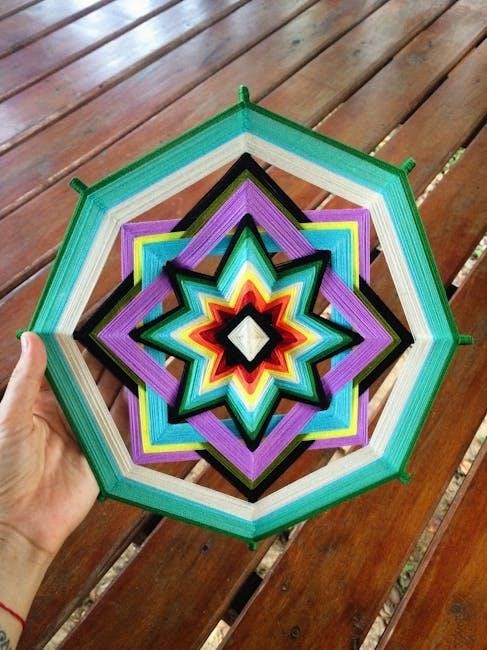Four-shaft weaving offers a versatile and creative approach to fabric design, enabling weavers to craft intricate patterns with ease. Popular among both beginners and experienced artisans, it allows for a wide range of textile designs, from simple to complex, making it a valuable resource for those exploring weaving techniques.
Overview of 4 Shaft Looms and Their Versatility
Four-shaft looms are highly adaptable tools, allowing weavers to explore a variety of techniques, from simple tabby weaves to intricate twills. Their versatility enables the creation of diverse fabrics, making them ideal for both beginners and advanced weavers. The ability to adjust threading and treadling patterns opens up endless design possibilities, while their compact size makes them accessible for home use. This versatility is a key reason why 4-shaft looms remain popular among weaving enthusiasts, offering a balance of creativity and practicality.

Importance of Patterns in Weaving
Patterns are the backbone of weaving, providing structure and creativity to fabric design. They dictate how threads interact, influencing texture, drape, and visual appeal. In 4-shaft weaving, patterns like tabby and twill form the foundation, allowing weavers to explore simplicity or complexity. These designs guide the placement of warp and weft threads, ensuring consistency and balance. Beyond aesthetics, patterns also affect the functionality of the fabric, such as its durability or softness. For learners, mastering patterns builds confidence and skill, while for experienced weavers, they offer endless possibilities for innovation. Whether for practical or artistic purposes, patterns are essential for achieving desired outcomes in weaving projects.

Understanding the Basics of 4 Shaft Weaving
Mastering 4-shaft weaving begins with understanding how shafts control warp threads. Threading, treadling, and setting up the loom correctly ensure proper pattern execution and fabric formation.
Threading and Treadling for Beginners
Threading and treadling are fundamental steps in 4-shaft weaving. Threading involves passing each warp thread through specific heddles and shafts according to the desired pattern. Treadling, on the other hand, involves depressing the treadles in a particular sequence to lift the shafts, creating the necessary shed for the weft yarn to pass through. For beginners, it’s essential to follow a clear threading plan and practice basic treadling sequences to ensure consistent and even fabric. Starting with simple patterns, such as plain weave or twill, allows new weavers to build confidence and skill before moving on to more complex designs. Proper alignment and tension of threads are crucial to avoid mistakes and achieve professional results.
Setting Up Your Loom for 4 Shaft Patterns
Setting up your loom for 4-shaft weaving patterns requires careful attention to detail to ensure proper functionality. Begin by threading the warp threads through the heddles and shafts according to your pattern design. Next, sley the reed to maintain even spacing and tension. Tie up the treadles to the shafts, ensuring each treadle corresponds to the correct lift sequence for your pattern. Advance the warp slightly to prevent threads from slipping out of the heddles. Proper tension is crucial—too loose, and the fabric may sag; too tight, and it could cause mechanical issues. For beginners, starting with a simple threading plan and practicing basic tie-ups can help build confidence. Always double-check your setup before weaving to ensure a smooth and enjoyable experience.

Common 4 Shaft Weaving Patterns

Four-shaft weaving patterns include simple twill, tabby, and their variations, offering versatility for creating unique fabrics. These patterns are popular for their ease of use and aesthetic appeal.
Simple Twill Patterns for 4 Shafts
Simple twill patterns on a 4-shaft loom are a great starting point for weavers. These patterns involve a specific sequence of lifting shafts to create diagonal lines in the fabric. A basic twill can be achieved with a 1-2-3-4 shaft sequence or its reverse, resulting in a smooth, drape-friendly fabric. One of the advantages of twill patterns is their versatility; they can be easily modified by changing the lift order or adding more shafts to create more complex designs. Visual aids, such as diagrams, are particularly helpful for understanding how different lift combinations affect the final texture. By experimenting with these variations, weavers can achieve a wide range of effects, from subtle to striking, in their projects. This makes simple twill patterns a foundational and enjoyable part of 4-shaft weaving.
Tabby and Its Variations in 4 Shaft Weaving
Tabby is a fundamental weaving pattern that serves as the foundation for many designs. On a 4-shaft loom, it involves a straightforward alternation of warp and weft threads, creating a balanced and durable fabric. The simplicity of tabby makes it an excellent starting point for beginners, while its versatility allows for endless creativity. One common variation is alternating tabby picks with pattern weft shots, as seen in two-shuttle weaves. This technique enhances texture and visual interest; Additionally, weavers can experiment with color changes or subtle treadling modifications to create unique variations. Tabby’s adaptability ensures it remains a cornerstone of 4-shaft weaving, offering both functionality and aesthetic appeal. Whether crafting simple linens or intricate designs, tabby provides a reliable base for exploration and innovation in fabric creation.
Advanced Techniques in 4 Shaft Weaving
Advanced techniques expand creative possibilities, enabling intricate designs through complex lift combinations and multi-layered patterns, while incorporating color and texture for enhanced visual and tactile appeal.
Creating Complex Patterns with Multiple Lifts
Complex patterns in 4 shaft weaving are achieved by utilizing multiple lifts, which involve strategic combinations of shaft raises. This method allows for intricate designs, as each lift sequence can create unique textures and visual interest. By experimenting with different lift orders, weavers can produce multi-layered effects, adding depth to their fabrics. The key is to plan sequences carefully, ensuring each lift contributes to the overall design without causing structural issues. This technique is particularly useful for creating dynamic and sophisticated textiles, making it a cornerstone of advanced weaving practices. Mastery of multiple lifts opens up endless possibilities for artistic expression in four-shaft weaving.
Incorporating Color and Texture in Your Designs
Incorporating color and texture into 4 shaft weaving patterns adds depth and visual appeal to fabrics. Weavers can experiment with yarns of varying weights and textures to achieve unique effects. Color can be introduced through warp or weft threads, creating vibrant contrasts or subtle gradients. Techniques like pick-up sticks allow for additional texture manipulation, enhancing the fabric’s tactile quality. The choice of yarn materials, such as wool, cotton, or silk, further influences the final texture and drape. By thoughtfully combining color and texture, weavers can create intricate, layered designs that stand out. This approach is particularly useful for crafting decorative textiles or custom garments with personalized aesthetics.
Resources and Further Reading
Explore detailed guides and patterns in books like Key To Weaving and join online weaving communities for shared knowledge and inspiration.
Recommended Books and PDF Guides for 4 Shaft Weaving
For in-depth guidance on 4 shaft weaving patterns, consider books like The Weaver’s Companion and Handweaving for Beginners, which offer detailed instructions and diagrams. PDF guides, such as those available on platforms like Amazon or craft stores, provide accessible and downloadable content tailored to 4 shaft techniques. These resources often include step-by-step tutorials, pattern designs, and troubleshooting tips. Many guides are designed for both novice and advanced weavers, ensuring a comprehensive learning experience. They cover topics like threading, treadling, and creating intricate designs, making them invaluable for mastering 4 shaft weaving. Whether you prefer physical books or digital formats, these resources can enhance your understanding and creativity in weaving.
Online Communities and Forums for Weavers
Weavers can connect with global communities through online forums like Ravelry, Facebook groups, and specialized weaving platforms. These spaces offer invaluable resources, including shared patterns, tips, and troubleshooting advice. Many forums dedicated to 4 shaft weaving patterns provide downloadable PDF guides and tutorials. Members often share their projects, inspiring creativity and collaboration. platforms like Weaving Today and Handweaving.net host active discussions and repositories of knowledge. These online hubs are perfect for learning from experienced weavers and staying updated on trends. Whether you’re seeking advice or showcasing your work, these communities foster growth and camaraderie among enthusiasts of all skill levels.


